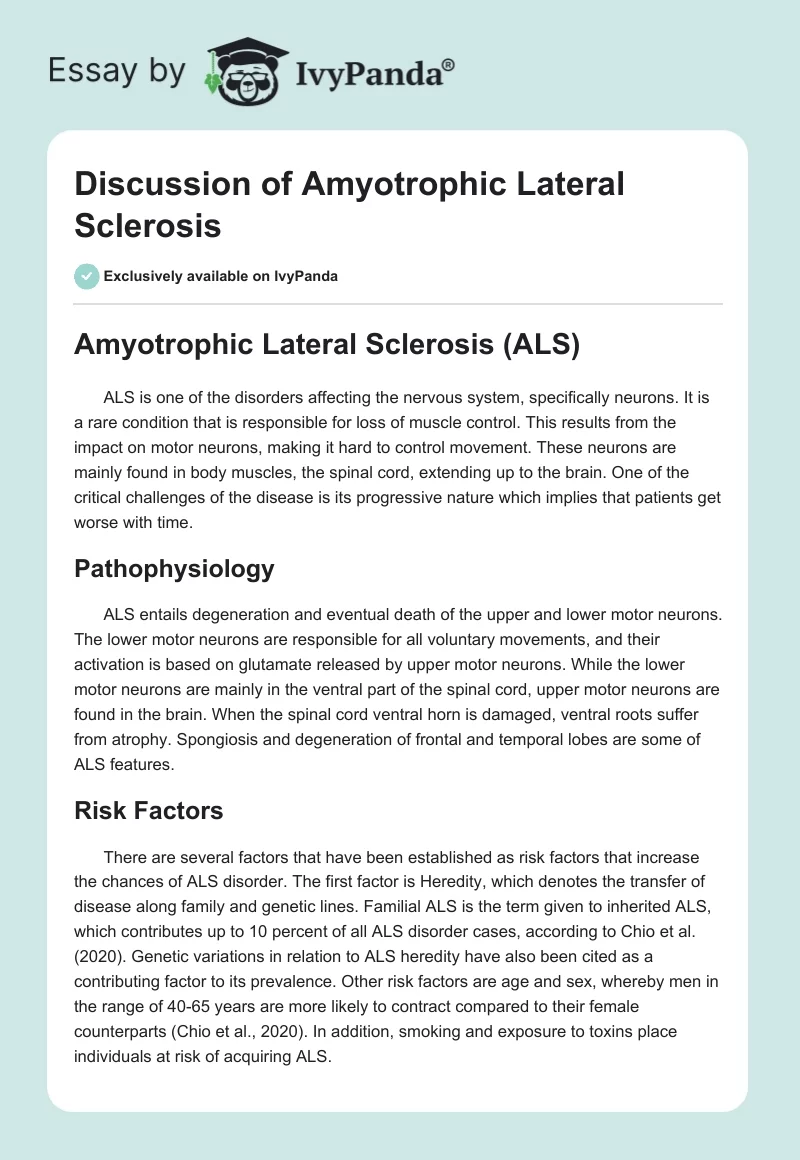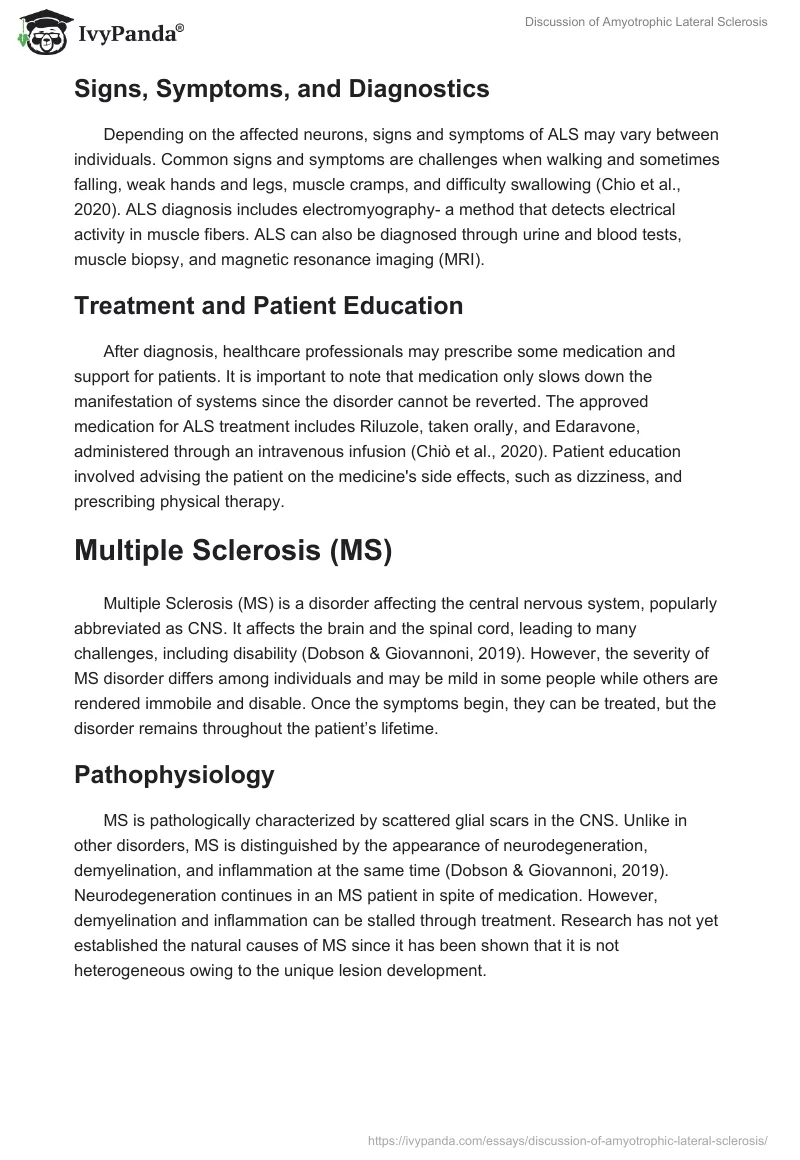Amyotrophic Lateral Sclerosis (ALS)
ALS is one of the disorders affecting the nervous system, specifically neurons. It is a rare condition that is responsible for loss of muscle control. This results from the impact on motor neurons, making it hard to control movement. These neurons are mainly found in body muscles, the spinal cord, extending up to the brain. One of the critical challenges of the disease is its progressive nature which implies that patients get worse with time.
Pathophysiology
ALS entails degeneration and eventual death of the upper and lower motor neurons. The lower motor neurons are responsible for all voluntary movements, and their activation is based on glutamate released by upper motor neurons. While the lower motor neurons are mainly in the ventral part of the spinal cord, upper motor neurons are found in the brain. When the spinal cord ventral horn is damaged, ventral roots suffer from atrophy. Spongiosis and degeneration of frontal and temporal lobes are some of ALS features.
Risk Factors
There are several factors that have been established as risk factors that increase the chances of ALS disorder. The first factor is Heredity, which denotes the transfer of disease along family and genetic lines. Familial ALS is the term given to inherited ALS, which contributes up to 10 percent of all ALS disorder cases, according to Chio et al. (2020). Genetic variations in relation to ALS heredity have also been cited as a contributing factor to its prevalence. Other risk factors are age and sex, whereby men in the range of 40-65 years are more likely to contract compared to their female counterparts (Chio et al., 2020). In addition, smoking and exposure to toxins place individuals at risk of acquiring ALS.
Signs, Symptoms, and Diagnostics
Depending on the affected neurons, signs and symptoms of ALS may vary between individuals. Common signs and symptoms are challenges when walking and sometimes falling, weak hands and legs, muscle cramps, and difficulty swallowing (Chio et al., 2020). ALS diagnosis includes electromyography- a method that detects electrical activity in muscle fibers. ALS can also be diagnosed through urine and blood tests, muscle biopsy, and magnetic resonance imaging (MRI).
Treatment and Patient Education
After diagnosis, healthcare professionals may prescribe some medication and support for patients. It is important to note that medication only slows down the manifestation of systems since the disorder cannot be reverted. The approved medication for ALS treatment includes Riluzole, taken orally, and Edaravone, administered through an intravenous infusion (Chiò et al., 2020). Patient education involved advising the patient on the medicine’s side effects, such as dizziness, and prescribing physical therapy.
Multiple Sclerosis (MS)
Multiple Sclerosis (MS) is a disorder affecting the central nervous system, popularly abbreviated as CNS. It affects the brain and the spinal cord, leading to many challenges, including disability (Dobson & Giovannoni, 2019). However, the severity of MS disorder differs among individuals and may be mild in some people while others are rendered immobile and disable. Once the symptoms begin, they can be treated, but the disorder remains throughout the patient’s lifetime.
Pathophysiology
MS is pathologically characterized by scattered glial scars in the CNS. Unlike in other disorders, MS is distinguished by the appearance of neurodegeneration, demyelination, and inflammation at the same time (Dobson & Giovannoni, 2019). Neurodegeneration continues in an MS patient in spite of medication. However, demyelination and inflammation can be stalled through treatment. Research has not yet established the natural causes of MS since it has been shown that it is not heterogeneous owing to the unique lesion development.
Risk Factors
Family history and previous infections are significant risk factors for MS. Individuals from families with a history of MS are at higher risk of contracting the disorder. In addition, infections such as Epstein-Barr can increase the risk of infection, as shown by Dobson and Giovannoni (2019). Auto-immune diseases such as psoriasis and thyroid disease have also been found to contribute to MS infection. Other risk factors include smoking, age, and sex. Women in the range of 20-40 years are twice as likely to contract MS compared to other groups (Dobson & Giovannoni, 2019). Climate can also be a contributing factor, with more cases reported in temperate climates.
Signs and Symptoms and Diagnostics
MS can affect different nerve fibers causing a range of symptoms that differ between individuals. Some of the most common symptoms are walking difficulties due to numbness in the legs, vision challenges, and speech problems (Dobson & Giovannoni, 2019). Slurred speech mainly results from lesions formed in the brain due to MS. Patients also notice a variation in their speech volume and maybe unclear in some instances. MS may also cause difficulties swallowing, sleeping, and cognitive challenges (Dobson & Giovannoni, 2019). MS is diagnosed through an MRI scan, spinal tap, and the visual evoked potentials (VEP) test. The MRI scan is used to identify scattered lesions while the VEP test detects electrical activity in the brain. Blood tests are also used to confirm that the results do not imply other linked conditions.
Treatment and Patient Education
MS, like other neural disorders, has no cure, and therefore treatment is intended to slow down the symptoms. According to Dobson and Giovannoni (2019), three types of medication are prescribed for MS patients: self-injectable, oral, and intravenous infusion medication. Dimethyl fumarate and Teriflunomide are some of the common oral medications taken, while Ocrelizumab and Alemtuzumab are used for intravenous infusion. Patient education may entail the need for physical therapy as it strengthens muscles and reduces MS symptoms. Patients can also be educated on medication adherence to ensure that they complete their medication and benefit more from the treatment and therapy.
Pulmonary Hypertension
Pulmonary hypertension can be described as high blood pressure affecting the pulmonary blood vessels. The disorder affects blood vessels that connect the heart to the lungs. When the blood pressure is too high, the blood vessels develop and increase muscle resistance. This usually is on the right side of the heart and may lead to ventricle failure in severe cases. Pulmonary hypertension happens in stages that differ in the severity of symptoms.
Pathophysiology
Pulmonary hypertension is characterized by a higher than normal mean arterial pressure. The pressure attributed to pulmonary hypertension is that higher than 25mmHg at rest and 30mmHg when in strenuous physical activity or exercises (Hoeper et al., 2017). It entails increased resistance of pulmonary vessels attributed to vasoconstriction, thrombosis, and to some extent, pulmonary vascular remodeling that happens to be uncontrolled. Increased vasoconstriction is believed to cause muscularization of the blood vessels on the right side of the heart (Hoeper et al., 2017). Vasoconstriction leads to a significant narrowing of blood vessels’ luminal area and is caused by hypoxia.
Risk Factors
Although pulmonary hypertension affects people of all ages, some factors increase the probability of infection. Family medical history, overweight, and congenital heart disease are the top three risk factors (Hoeper et al., 2017). When a family line has a history of pulmonary hypertension, the chances are that individuals from that family are more likely to get the disorder. Drugs can also increase the risk of infection, especially cocaine and some weight-loss drugs. In addition, people in the range of 30-60 years are the most affected (Hoeper et al., 2017). Since this is a disease affecting the blood system, a history of blood clotting increases the risk of infection.
Signs and Symptoms, and Diagnostics
After infection, symptoms develop slowly and worsen as the ailment progresses. Patients may notice signs of fatigue and difficulty breathing when at rest or during normal exercises (Hoeper et al., 2017). Palpitations and chest pressure are also symptoms that can be noticed early in patients. Sometimes, patients may suffer from dizziness and even fainting as the disease worsens. Pulmonary hypertension is diagnosed through a chest x-ray, echocardiogram, blood tests, and electrocardiogram.
Treatment and Patient Education
Treatment for pulmonary hypertension entails lowering the expression of symptoms. Treatment includes Endothelin receptor antagonists aimed at treating the endothelium, vasodilators for improving blood flow, and surgery in case of failed medications (Hoeper et al., 2017). In severe cases, a heart or lung transplant may be necessary. Since the disease is highly influenced by lifestyle, patient education should focus on healthy eating habits, exercise, and following the prescribed medication without fail.
Wilms Tumor
Pathophysiology
Wilms tumor, also referred to as nephroblastoma, is a type of kidney cancer prevalent in children. Wilms tumor may affect one or both kidneys, while some patients may have several cancers in a kidney. Unilateral Wilms tumor is more common than bilateral, with the latter contributing up to 10 percent of reported cases (Oostveen & Pritchard-Jones, 2019). Wilms tumor is associated with the deletion of a gene responsible for suppressing Wilms tumor known as WT1.
Risk Factors, Signs and Symptoms, and Diagnostics
Although there is no established cause of Wilms tumor, some factors increase the risk of infection. Age is a significant factor in this case since the Wilms tumor affects children between the ages of 3 and 4 years (Oostveen & Pritchard-Jones, 2019). Family history and congenital disabilities also increase the risk of infection. According to Oostveen and Pritchard-Jones (2019), gender also plays a significant role because girls are more likely to be affected than boys in the same conditions. Some common signs include abdominal pain and swelling, fever, and an abdominal mass. Wilms tumor is diagnosed through physical examination, imaging, and blood and urine tests.
Treatment and Patient Education
Wilms tumor develops in stages, and therefore its treatment is based on the severity of infection. A doctor establishes the stage and then recommends one of the three main treatment options: surgery, chemotherapy, and radiation therapy (Oostveen & Pritchard-Jones, 2019). Surgery is done to remove part of the whole kidney affected by Wilms tumor. Patients may be educated on the need to seek medical care as soon as they notice the symptoms to increase the chances of successfully removing the tumor.
References
Chiò, A., Mazzini, L., & Mora, G. (2020). Disease-modifying therapies in amyotrophic lateral sclerosis.Neuropharmacology, 167, 107986.
Dobson, R., & Giovannoni, G. (2019). Multiple sclerosis–a review.European journal of neurology, 26(1), 27-40.
Hoeper, M. M., Ghofrani, H. A., Grünig, E., Klose, H., Olschewski, H., & Rosenkranz, S. (2017). Pulmonary hypertension. Deutsches Ärzteblatt International, 114(5), 73. doi: 10.3238/arztebl.2017.0073
Oostveen, R. M., & Pritchard-Jones, K. (2019). Pharmacotherapeutic management of Wilms tumor: an update. Pediatric Drugs, 21(1), 1-13.


